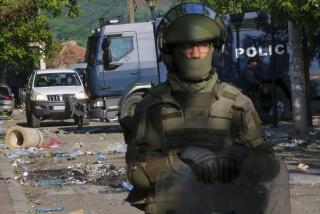Next Step : A Rumor of Renewed War : Across a U.N.-patrolled buffer zone, Serbs and Croats eye each other suspiciously in the Krajina region. What will happen if the peacekeepers start withdrawing?
- Share via
VOJNIC, Croatia — In this mountain village deep inside territory internationally recognized as Croatian, the uniformed Serbian rebels are on war alert, smoking cigarettes over their coffee and talking tough.
“If the Croats want war, they’ll get war,” said a Serbian corporal, raising his eyes to catch a glimpse of the subtitled, afternoon American movie on Bosnian Serb TV. “But this time we’ll do it properly.”
Across a buffer zone monitored by U.N. troops, though, the Croatian government is ready to gamble that such words are mere bravado.
“There’s such an overexaggeration of the military power of the Serbian forces,” said Zoran Bosnjak, an adviser to Croatia’s foreign minister. “It’s just incredible the way it’s exaggerated.”
Talk like that, on both sides of the front line, has the world worried.
The Croatian government is determined to follow through on its promise to order 12,000 U.N. troops to begin moving out by the end of March from the zone between the Croatian heartland and the mountainous one-third of its territory still held by rebel Serbs.
If the U.N. troops leave, military analysts figure, both sides will rush to seize mountaintops, river crossings and other strategic points in the 1.2-mile-wide, U.N.-held zone. Weapons caches now under U.N. guard will be opened.
And a 10-month-old cease-fire will be doomed. An expanded war, a war that could easily spread throughout the Balkans, will be a trigger-pull away. “If the U.N. leaves,” a U.N. official says, “it will be like pouring gasoline on glowing embers.”
The road to Vojnic illustrates the situation. Leaving Croatia, population 4.7 million, one passes the Croatian border police checkpoint. A mile later is the first U.N. checkpoint and, then, the armed Serbian militiamen who control entry to the place they call the Republic of Serbian Krajina.
In this “republic,” abutting the western border of troubled Bosnia-Herzegovina, the Serbian population, estimated at 300,000, lives under its own national flag and uses its own currency.
Yet the international community considers the Krajina, as the region is known, part of Croatia. But the cost of the Serbs’ declaration of political independence is evident everywhere. The 1991 Serbo-Croatian war, fought over this soil, left many towns in rubble. Many of the homes and businesses belonged to Croatians, killed or forced to flee during the fighting.
Water plants have been shut down. Electricity is rationed. Telephone calls to the outside world aren’t possible, except for those few with cellular phones. Most of the factories are shut. The prices for everything from toilet paper to gasoline are twice those in Croatia.
And war never seems very far away. From the weedy town square in Vojnic, population 13,500, the latest shelling of Bihac, about 30 miles away in Bosnia, can be heard.
Few here want a renewal of the war, but they fear it is inevitable. If the United Nations leaves, they know the Croatian government will try to retake its soil, forcing the Krajinans to live under the Croatian flag. A negotiated solution would be possible, but the Krajina leaders have refused to talk unless the United Nations promises to stay.
Jadranka Ivosevic,18, a college student who has grown to her maturity in this conflict, believes that re-integration of the Krajina into Croatia will never happen by negotiation for one practical reason: “All our men are considered war criminals in Croatia, and they can never just surrender.”
Ivosevic is studying to be a teacher, taking courses in a college woefully short of water--and teachers. Her father, who supported the family working as a locksmith, in a local factory, lost his job when war closed the factory. Now he, like 50,000 of the able-bodied men in the Krajina, is a soldier, earning just $15 a month.
“I have a question for you,” Ivosevic said to a foreign reporter. “Do you think the U.N. will withdraw?” It is the question on everyone’s mind.
The Croatian government says it would be willing to accept a different international deployment in this region, and the United Nations is trying to come up with some ideas. But U.N. troops standing between Croatia and the Krajina? Not a chance, Croatia says.
The time has come to shake things up, the Croatian government thinks. High-ranking officials in the capital, Zagreb, believe that the U.N. presence has lulled the Krajina’s leaders into a false sense of security, making them think that sovereign statehood is still an option.
“The U.N. has been preserving a negative status quo,” said Bosnjak, the Croatian Foreign Ministry official. “And we have to change some of the basic ingredients in this former Yugoslavian brew.”
Although Bosnjak says the Croatian government realizes a renewed war is possible, he doesn’t consider it inevitable. “We will show a high degree of tolerance for small-scale provocations,” he said.
For many in the Krajina, the prospect of war, however distasteful, brings with it the hope of an end to their isolation. “This war will be the one that lasts until one of us capitulates,” one Serbian soldier said.
“This country of ours was difficult to create,” said Milos Vucinic, secretary of the City Council here. “And now we’re supposed to give it up to become second-class citizens in Croatia.”
Vucinic spoke in the City Hall, where stooped women carried satchels of firewood from office to office, replenishing the heating stoves. Behind him was a wall-sized map of the city and its many factories, now starved for lack of raw materials.
A possible solution to the conflict was offered a few weeks ago in an initiative led by the U.S. and Russian ambassadors to Croatia. They drew up an autonomy plan that would allow the Krajina region substantial independence within Croatia, giving the Serbs here the ability to raise taxes and their own flag, among other things.
The Croatian government accepted the plan as a basis for negotiations. But the Krajina Serbs refused to even look at it, demanding instead that the United Nations first agree to not withdraw.
Now the Krajina Serbs are mobilizing for war. New trenches are being dug. Rifles are being cleaned. And reserve soldiers must have permission from their commanders to leave their towns.
If there is a war, it will be much different from the 1991 war, analysts say. The Croatian government, whose army outmans the Krajina Serb army 2 to 1, has had three years to build up its arms.
The rebels, though, remain well armed, and they recently signed a military cooperation agreement with the strong rebel army of Bosnian Serbs, formalizing a de facto alliance.
Most analysts think the Croatian government is overestimating its military strength, though they acknowledge that government forces could win back at least some of the Krajina.
The price in lives on both sides would be high, and Zagreb might even be the target of some shelling. But recent public opinion polls suggest that the Croatian people support their president, Franjo Tudjman, and are willing to run the risk of war.
Tudjman “is a risk taker. He’s gambling the Serbs won’t attack, just like he did in 1991,” said Ivo Banac, a Croatian intellectual and history professor at Yale. “He was wrong then, and he’s wrong now.”
Meanwhile, U.N. officials in this part of the Krajina are nervously watching the Serbian military buildup.
Before the latest rise in tensions, the United Nations had been heartened by the success of an economic agreement signed in December between Croatia and leaders of the Krajina.
Thanks to that accord, an oil pipeline has reopened, cars with Croatian as well as Krajinan license plates are driving again on a U.N.-patrolled road in the Krajina, and one electrical generating plant is back on line.
But talks to implement other parts of the accord have been suspended by the Krajina Serbs since mid-February, again in a bid to force the United Nations to remain. So far, the world body has taken no steps to withdraw, hoping to avoid doing anything that would panic the local population.
When and if the withdrawal begins, probably with the help of North Atlantic Treaty Organization air power, U.N. officials think the Krajina Serbs might try to stop it by taking U.N. officials hostage or, in a more likely scenario, using women and children to block the roads.
The United Nations hasn’t always felt welcome here, of course. In the last two months, armed gangs have stolen 30 U.N. vehicles. The cars and trucks were repainted and driven around the region’s small villages, obvious to everyone except, of course, the local police.
The police started to act on U.N. complaints only when it appeared the forces might be leaving.
“It’s funny how things have changed,” said James Kanu, the U.N. spokesman in Topusko, about 30 miles east of here. “A few weeks ago the people in the Krajina were saying we were useless. Now they’re saying, ‘Don’t go.’ ”
More to Read
Sign up for Essential California
The most important California stories and recommendations in your inbox every morning.
You may occasionally receive promotional content from the Los Angeles Times.














